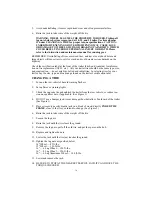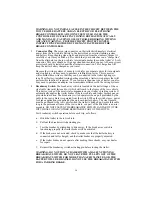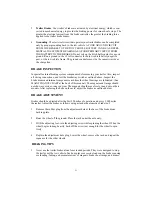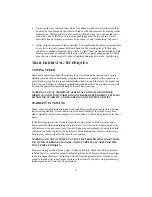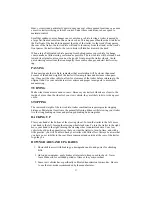
9
The following label has been affi xed to the bumper:
CAUTION: THE BUMPER IS DESIGNED TO CARRY THE SPARE TIRE ONLY.
DO NOT PLACE ADDITIONAL CARGO ON THE BUMPER.
•
If possible, totally fi ll or empty the water tank to minimize “sloshing,” which may
affect towing stability.
•
If possible, empty holding tanks to minimize “sloshing,” which may affect towing
stability.
•
Be careful to load the trailer to comply with the specifi ed maximum and minimum
tongue weight percentages. Weigh the fully loaded trailer from time to time to verify
tongue weight.
•
Adjust the hitch ball height so that the fully loaded trailer is level front-to-rear when
attached to the fully loaded tow vehicle with hitch spring bars tightened. Do not
permit the front to be lower than the rear on trailers with tandem axles. (Fifth wheel
trailers are less sensitive to altitude, but should be towed near level to achieve best
stability and avoid the possibility of overloading one of the trailer axles.)
•
Do not exceed the trailer Gross Axle Weight Rating(s) (GAWR), or Gross Vehicle
Weight Rating (GVWR). The fully loaded trailer should be weighed from time to
time to verify that trailer GAWR(s) and GVWR are not exceeded, and that the loads
on the right and left wheels are approximately equal. When weighing to determine
axle loading, the trailer must be fully loaded and hitched to the fully loaded tow
vehicle, with spring bars tightened. (Spring bars do not apply to fi fth wheels.)
•
Do not exceed the tow vehicle Gross Axle Weight Rating(s) (GAWR) or Gross
Vehicle Weight Rating (GVWR). Weigh the tow vehicle from time to time to verify
these loadings. When weighing, the tow vehicle must be fully loaded with goods,
passengers, and driver, and must be hitched to the fully loaded trailer, with spring
bars tightened. (Spring bars do not apply to fi fth wheels.)
TRAILER LOADING
Proper trailer positioning and loading are important not only for ease of hauling, but for
safety. The correct loaded weight on the hitch is a minimum of eight percent of trailer
weight. Fifth wheel trailers should carry higher hitch loads (15 to 25 percent). If insuf-
fi cient weight is placed on the hitch, the trailer will tend to move from side to side, or to
“fi shtail”, which can be dangerous. Towed trailers are designed to have proper weight on
the hitch for balance when the trailer fl oor is level.
All objects should be held securely in place. Loose items can cause interior damage and
erratic trailer movements. They can even be a hazard to others if they fall out. Load shifts
can affect driving and handling enough to cause serious, unexpected danger. Inspect tie-
downs and fastenings, as well as the load at regular intervals every hour or two, depend-
ing on roads, curves, hills, and speed. The fi rst check should be made within a half hour
after the trip is started or after the fi rst 25 miles, since some initial settling is likely.
Summary of Contents for TRAVEL TRAILER FIFTH WHEEL
Page 1: ...1 TRAVEL TRAILER FIFTH WHEEL OWNERS MANUAL This Quality Recreational Vehicle Built By...
Page 4: ...4...
Page 17: ...17 Figure 3 NEVER USE BUMPER JACKS Figure 2 TYPICAL SCISSOR JACK Figure 1 TYPICAL WHEEL CHOCKS...
Page 64: ...64 TRAVEL TRAILER AND FIFTH WHEEL SLIDE OUT ROOM ADJUSTMENT AND OPERATION...
Page 81: ...NOTES...
Page 82: ...NOTES...
Page 83: ...Corporate Of ce P O Box 743 Elkhart Indiana 46514 1584 1 800 755 6521 05 05...


















